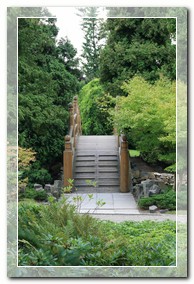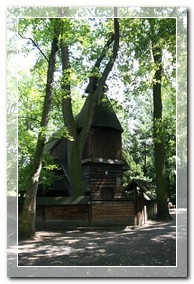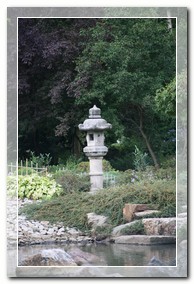


 he Szczytnicki Park
with its 100 hectares is one of the largest parks in Wroclaw. It owes
its name to the closeness of the Szczytniki village, where in the Middle
Ages shields were made (the old name for shields is “szczyty”). As the
time went by, the neighboring population was gradually germanized, the
name became more and more inexplicable and many myths grew around it.
The citizens of Wroclaw thought for example that the bust of the
Prussian king Frederic Wilhelm II, put in the park by the duke Hohenloh,
represented the banker Scheitnig, who supposedly established the park
and gave it to the city. The legend says that a certain knight also
understood the name of the village providently. He was on the pilgrimage
to the Holy ground,
he Szczytnicki Park
with its 100 hectares is one of the largest parks in Wroclaw. It owes
its name to the closeness of the Szczytniki village, where in the Middle
Ages shields were made (the old name for shields is “szczyty”). As the
time went by, the neighboring population was gradually germanized, the
name became more and more inexplicable and many myths grew around it.
The citizens of Wroclaw thought for example that the bust of the
Prussian king Frederic Wilhelm II, put in the park by the duke Hohenloh,
represented the banker Scheitnig, who supposedly established the park
and gave it to the city. The legend says that a certain knight also
understood the name of the village providently. He was on the pilgrimage
to the Holy ground,  to pray and beg for the awaiting for a
long time descendant. When accompanied by his wife to Wroclaw, where
they were suppose to say goodbye, he asked about the name of the village
and heard "Szczytniki", he understood this as "Scheid nicht", that is
"don't separate" and he gave up the expedition. Staying with his wife,
instead of wandering around the world far away from the marital bed, he
was quickly presented with the awaited descendant.
to pray and beg for the awaiting for a
long time descendant. When accompanied by his wife to Wroclaw, where
they were suppose to say goodbye, he asked about the name of the village
and heard "Szczytniki", he understood this as "Scheid nicht", that is
"don't separate" and he gave up the expedition. Staying with his wife,
instead of wandering around the world far away from the marital bed, he
was quickly presented with the awaited descendant.
The history of the Park began in the year 1783, when the commander officer of the Wroclaw's garrison, Frederic Ludwik Hohenlohe–Engelfingen purchased the lying near the Szczytniki village forest famous for its beauty and prepared there one of the first English style parks on the European continent. In the contrast to the regular baroque gardens, English parks were full of free and romantic garden compositions, in which elements linking to antiquity, Middle Ages, country life, and often also to oversea exotic forms were set. The best example of this is the small wooden church under the call of John Nepomucen build at the end of the XVI century, originally in Stare Koźle, from where it was transferred to Kędzierzyn, and then in 1913 to the Szczytnicki Park.
 In the years 1909–1912, to
celebrate the Century Exhibition organized in 1913 the Japanese Garden
was established in the Park. It was renewed during the last years with
the co-operation of the Japanese embassy, professor Ikuya Nishikawa and
gardeners from Nagoya, and the government of Japan gave to Wroclaw
several XIX century street lamps made of granite to this adorned "piece
of Japan" in the centre of Wroclaw. The garden looks beautiful the whole
year, but it is gorgeous in the breakthrough of May and June (depending
on the weather), when azaleas and rhododendrons bloom - it reminds a
painting of an impressionist with its flickering colors.
In the years 1909–1912, to
celebrate the Century Exhibition organized in 1913 the Japanese Garden
was established in the Park. It was renewed during the last years with
the co-operation of the Japanese embassy, professor Ikuya Nishikawa and
gardeners from Nagoya, and the government of Japan gave to Wroclaw
several XIX century street lamps made of granite to this adorned "piece
of Japan" in the centre of Wroclaw. The garden looks beautiful the whole
year, but it is gorgeous in the breakthrough of May and June (depending
on the weather), when azaleas and rhododendrons bloom - it reminds a
painting of an impressionist with its flickering colors.
The largest trump of the Park is probably its plant richness - one can see in it over 400 species of trees and shrubs, arranged in picturesque compositions. That is why it is the favorite place of the citizens of Wroclaw to spend a weekend and rest, what you can see after the satisfied face of our daughter, prowling through the lawns of the park:

One should mention that though the Szczytnicki Park is the oldest and the largest park in Wroclaw, it is not the only one. Wroclaw is a city of greenery, possessing except of the Szczytnicki Park also 64 other parks. Park terrains occupy the total surface of 1394 hectares.




















































